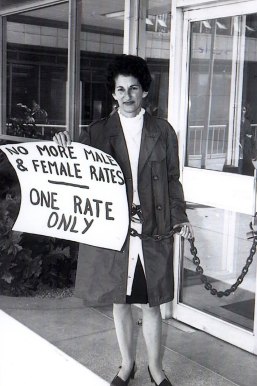It’s a hot day, and some bastard arbitrator is telling you, officially, that women don’t deserve to be paid as much as men. So you chain yourself to the exit of a Commonwealth building to demand the government get serious on equal pay.

I was nervous. I set up Trades Hall’s handycam and gushed “I read your book!” - she replied “I should hope so, if you’re going to be interviewing me”. It was badass. She didn't feign modesty or minimise herself - she knew that she was someone worth reading about.
Zelda was a polarising figure. She had many comrades, but also plenty of detractors. You’d expect nothing less of a woman who quit the Communist Party in objection to their patriarchal politics. But these days, women of the union movement hold her in high esteem. Her exploits – including the chain up, but also stunts like only paying 75% of the tram fare to highlight the injustice of unequal pay – are legendary. It is whispered around the corridors of Trades Hall that she was even the first woman unionist to start drinking with the boys at the John Curtin after work. We truly walk in the footsteps of giants.
Zelda’s parents had suffered anti-Semitic persecution before migrating to Melbourne. Her mother Rachel Leah Orloff was appalled by the slum conditions of Carlton, and in Zelda’s words, soon swapped her religion for membership of the Communist Party, seeking to make the world a fairer place.
As a working-class kid, Zelda left school at 14 to support her family, knocking around jobs as biscuit maker, usherette, seamstress, nurse and office worker, but always a committed trade unionist. She married Charlie D’Aprano at 16 and gave birth to her daughter Leonie a year later.
When she came to work for the Australasian Meat Industry Employees Union, she was shocked at the conditions inside Trades Hall. (The heating and cooling, I admitted in 2014, had not improved.) It was inside these run-down offices where Zelda was invited to a meeting of women unionists in 1969, to discuss how they might advance the equal pay case. At that first meeting, only one other woman, Diana Sonenberg, Secretary of the Insurance Staff Federation, turned up – but she and Zelda spoke of their admiration for the tactics of suffragist women in the UK, and together they devised the plan for the chain-up.
The history we are taught in school tends to gloss over and erase the organising work that goes into civil rights. Everyone knows that Rosa Parks refused to give up her seat on the bus, but the protest is often portrayed as spontaneous - few know that she was a community organiser and activist who had planned the stunt meticulously with the NAACP.
Zelda’s protest necessitated planning and resources; the women had cased the commission earlier to determine the length of chain to use. Jim Donnegan from the Painters and Dockers had donated the chain to Zelda on the condition of strict anonymity, which she honoured until after his death. The media had all been called and were in attendance. Placards, held aloft by other women activists, had been painted. Zelda had not eaten or drunk anything all day before the chain-up, worried that she would need to go to the bathroom. A journalist who snapped her picture sneered at her - “what do you possibly hope to achieve here? You’re just one woman”. Canonically, she replied “Today it was me, tomorrow there will be two of us, the next day four and it will go on and on and there won’t be any stopping it”.
The media coverage of Zelda’s chain-up attracted more women activists, despite the squeemishness of unions about the whole matter. After another chain-up - this time with two striking teachers - the “Women’s Action Committee” was formed. By the 1970s they were campaigning against workplace discrimination, sexist advertising, and for abortion law reform. It went on and on...there was no stopping it.
In 2012 ASU members in the community sector won pay rises between 19-41% after arguing the sector was systematically underpaid because the work was predominantly performed by women. Activists campaigned in their thousands, in workplaces, in the streets, and in the media.

Back in Zelda’s living room, I asked how she liked speaking from the back of a rally truck at a feminist protest as an octogenarian. She laughed.
“When I was invited to speak at the union rally outside Trades Hall, I had no idea what form this was going to take. When I saw the crowds – several thousand and mainly women – I was astonished.”
“I was so excited and thrilled to see this because for years I had gone to trade union meetings where we were lucky if there were five women there, and none of them saying anything. And here were these thousands of women – and so enthusiastic participating in this big demonstration”.
“It’s something I always wanted to see, and here I was looking at it.” Her voice shook.
“Oh sisters, you’ve done me proud”.
In 2018 Zelda passed away, but not before seeing how her story was already becoming legend in the trade union movement that had spurned her many years earlier. Trades Hall was awarding an annual “Zelda award” for women activists, and she was celebrated at annual Women’s Rights at Work festivals.
Soon Zelda’s story will become a permanent feature at Trades Hall. A statue crafted by local artist Jennifer Mann is scheduled to be unveiled in May, funded by hundreds of women activists with substantial support from the Victorian State Government, A Monument of One's Own and unions.
Edwina Byrne is the Communications Lead & Workers Museum curator at Victorian Trades Hall Council

